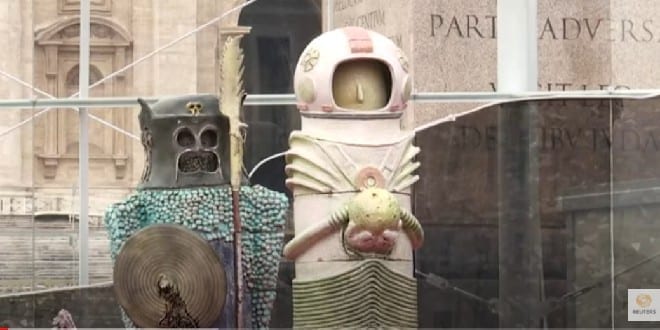On Friday, the Vatican unveiled a scene depicting the birth of Jesus that included a disturbing statue of an astronaut and a demonic-looking executioner knight dubbed by many viewers as “Darth Vader”, the antagonist in Star Wars known for his black armor.
Nativity Scene: Un-Conventional or Simply Ug-Ly
The Vatican described the scene composed of 20 ceramic figures as “contemporary and unconventional.” It is described as “post-modern artistic” by its (precious few) supporters. But tts numerous detractors have taken to social media where the words “hideous,” “abhorrent”, a “disgrace,” an “embarrassment” and a “mockery” frequently appear. Some have even called it “demonic” and the UK’s Daily Telegraph called it “absolutely terrifying.”
This year’s #Vatican Nativity scene, revealed tonight, comes from a town in the Abruzzi region of Italy famous for its ceramics. Its creators say it’s meant to have a contemporary and unconventional look influenced by ancient Greek, Sumerian and Egyptian art. Photo: @dibanezgut pic.twitter.com/ozEeaQWJ6r
— Edward Pentin (@EdwardPentin) December 11, 2020
The Vatican’s presentation was devoid of context with no trees or landscape that are usually present in nativity scenes. A single slash of a white neon tube bent at sharp angles, may have been intended to represent a minimalist silhouette of a mountain range, but many commented that it appeared as a glowing lightning bolt ready to strike the family Jesus. The figure depicting baby Jesus is still hidden under a red silk veil.
The shortcode is missing a valid Donation Form ID attribute.
The ceramic figures were made in 1965-1975 as part of a 54-statue collection in the Abruzzi region of Italy famous for its ceramics. Conceived by Stefano Mattucci, the then-director of the town’s F.A. Grue Institute of Art, and designed by two artistic professors, Gianfranco Trucchia and Roberto Bentini, the scene was first exhibited in December 1965, then displayed at Trajan’s Market in Rome in 1970, and a few years later in Jerusalem, Bethlehem and Tel Aviv.
“Its creators say it’s meant to have a contemporary and unconventional look influenced by ancient Greek, Sumerian and Egyptian art,” Edward Pentin, the Rome correspondent for the National Catholic register, tweeted.
This year’s #Vatican Nativity scene, revealed tonight, comes from a town in the Abruzzi region of Italy famous for its ceramics. Its creators say it’s meant to have a contemporary and unconventional look influenced by ancient Greek, Sumerian and Egyptian art. Photo: @dibanezgut pic.twitter.com/ozEeaQWJ6r
— Edward Pentin (@EdwardPentin) December 11, 2020
This year’s #Vatican Nativity scene, revealed tonight, comes from a town in the Abruzzi region of Italy famous for its ceramics. Its creators say it’s meant to have a contemporary and unconventional look influenced by ancient Greek, Sumerian and Egyptian art. Photo: @dibanezgut pic.twitter.com/ozEeaQWJ6r
— Edward Pentin (@EdwardPentin) December 11, 2020
But even Pentin was perplexed at images resembling skeletons peeking around round column bases.
This year’s #Vatican Nativity scene, revealed tonight, comes from a town in the Abruzzi region of Italy famous for its ceramics. Its creators say it’s meant to have a contemporary and unconventional look influenced by ancient Greek, Sumerian and Egyptian art. Photo: @dibanezgut pic.twitter.com/ozEeaQWJ6r
— Edward Pentin (@EdwardPentin) December 11, 2020
Equally perplexed was the Jesuit America Magazine which referred to onefigure wearing an black helmet as “Darth Vader.”
Art historian Elizabeth Lev lives in Rome and had a similar visceral reaction to the Vatican’s artistic endeavor.
So the Vatican presepe has been unveiled….turns out 2020 could get worse… pic.twitter.com/xI2NMNn81r
— Elizabeth Lev (@lizlevrome) December 11, 2020
In Christian tradition dating back to the 13th century, presepe are small scenes are arranged before Christmas, representing the birth of Jesus in Bethlehem, Israel, as it is described in their New Testament. The scene depicts Jesus as a baby in a manger flanked by his mother and father and gathered emissaries. In addition, figures representing farm animals and angels can also be presented. n 1982, Pope John Paul II inaugurated the annual tradition of placing a nativity scene on display in the Vatican City in the Piazza San Pietro before the Christmas Tree.
The current display is scheduled to remain until January tenth.
The shortcode is missing a valid Donation Form ID attribute.




